End Of Season Feelings On Tiger and Bunny With Bismarck Kamen
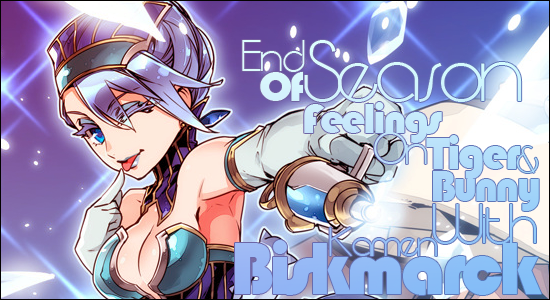
What’s that I hear? It sounds like another super hero article headed this way. This looks like a job for our friendly neighborhood owl-themed crime fighter, Bismarck Kamen! Today we break away from the usual format of the Owl in the Rafters segment to focus on just one series as opposed to a collection of related titles. I’d like to go over a series that just ended recently, and that I had held particularly high hopes for throughout the Summer season: Tiger & Bunny.
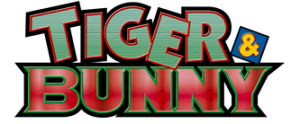 There has been quite a bit of advertising for this show since it was first scheduled for it’s debut back in April, mostly drawing attention to Viz Media’s simulcast of the subtitled episodes over American industry approved streams. At first I actually ignored most of the hype over it and let the first three episodes slip by me. Between the name itself, the actual title art, and the design of the central heroes I was very distinctly disinterested and didn’t even feel compelled to look up a synopsis of the show. I did however manage to hear a little bit of the basic premise while talking with some friends and the idea nearly knocked me off my feet.
There has been quite a bit of advertising for this show since it was first scheduled for it’s debut back in April, mostly drawing attention to Viz Media’s simulcast of the subtitled episodes over American industry approved streams. At first I actually ignored most of the hype over it and let the first three episodes slip by me. Between the name itself, the actual title art, and the design of the central heroes I was very distinctly disinterested and didn’t even feel compelled to look up a synopsis of the show. I did however manage to hear a little bit of the basic premise while talking with some friends and the idea nearly knocked me off my feet.
The show is set in the city of Sternbild, a mix of gilded metropolitan retrofuture and an almost borderline cyberpunk kind of sci-fi alternative to 1970s Manhattan where super powered humans known as NEXT exist as both super heroes out to protect the public and super villains out to benefit themselves. Pretty standard North American style comic book super hero set up so far, right?
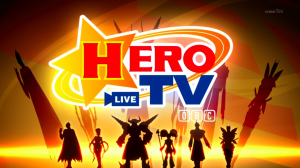 What blew me away was this little twist: in Sternbild the super hero NEXT are all employed by a television program called HERO TV, which deploys both heroes and TV crew at the first sign of trouble. The HERO TV program then broadcasts the crime fighting and scores each hero based on his/her performance, awarding points for rescuing civilians, preventing public damage, and of course actually apprehending criminals. To facilitate this program, each hero is sponsored by multiple corporate entities. The result is almost akin to NASCAR racers, with each hero’s outfit plastered with logos and brand names.
What blew me away was this little twist: in Sternbild the super hero NEXT are all employed by a television program called HERO TV, which deploys both heroes and TV crew at the first sign of trouble. The HERO TV program then broadcasts the crime fighting and scores each hero based on his/her performance, awarding points for rescuing civilians, preventing public damage, and of course actually apprehending criminals. To facilitate this program, each hero is sponsored by multiple corporate entities. The result is almost akin to NASCAR racers, with each hero’s outfit plastered with logos and brand names.
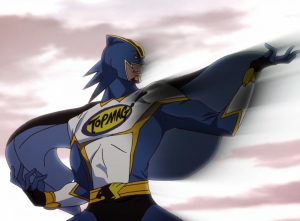 In this setting we follow Kaburagi Kotetsu, alias Wild Tiger, a clumsy, unpopular, middle aged super hero and single father as his company sells him to a different company that slaps him together with a young up and coming hero and deadpan Mr.Perfect, Barnaby Brooks Jr. Other than trying to get along with his partner, arguing what it means to be a true hero, and of course actually stopping criminals, Kotetsu must also try to maintain his relationship with his young teenage daughter, Kaede.
In this setting we follow Kaburagi Kotetsu, alias Wild Tiger, a clumsy, unpopular, middle aged super hero and single father as his company sells him to a different company that slaps him together with a young up and coming hero and deadpan Mr.Perfect, Barnaby Brooks Jr. Other than trying to get along with his partner, arguing what it means to be a true hero, and of course actually stopping criminals, Kotetsu must also try to maintain his relationship with his young teenage daughter, Kaede.
What made this such a fascinating premise was that it was a genuinely unique spin on what is frankly a quickly growing stale super hero image in American comics. Established franchises do fine as they are, but there really aren’t any clever or unique twists that manage to really press the limits of the standard formula. What we had here, from Japan of all places, was a premise with legitimate potential to fuse the tried and true appeal of super powered heroism with the humanist and social realist appeals of a working class drama.
That is not what the show turned out to be.
Instead of a ground breaking story of a man torn between upholding justice and maintaining a sense of professionalism, while juggling the standard job -vs- family routine, what I found myself tuning in to every week was roughly 10 episodes of generic anime sitcom nonsense with an episode dedicated to each of the supporting cast heroes, a “Let’s throw the grumpy guy a birthday party” episode, and other such nonsense eventually leading up to a few returning villains to take the spot light for a couple episodes at a time.
I’ll give you a brief rundown of the heroes before moving on:
 Barnaby and Kotetsu are of course the main heroes, and as such tend to have the least interesting characteristics. Barnaby Brooks Jr. is made notable as the only hero to fight crime under his own name. He fills the role of generic straight faced, serious, pretty boy as foil to Kotetsu’s constant blundering. He tends to be aloof and cool headed, if only to emphasize the moments where he looses his cool, which ends up happening more often than not by the end of the show, which really begs to question if he can even be called cool headed or not when his keep-calm count is about on par with his flip-out count. Barnaby’s suit contains ads for Bandai, Crusade System Card Series (a subsidiary of Bandai that produces a number of cardgames tied into other Bandai properties), and Amazon.co.jp. His corporate sponsor is Apollon Media.
Barnaby and Kotetsu are of course the main heroes, and as such tend to have the least interesting characteristics. Barnaby Brooks Jr. is made notable as the only hero to fight crime under his own name. He fills the role of generic straight faced, serious, pretty boy as foil to Kotetsu’s constant blundering. He tends to be aloof and cool headed, if only to emphasize the moments where he looses his cool, which ends up happening more often than not by the end of the show, which really begs to question if he can even be called cool headed or not when his keep-calm count is about on par with his flip-out count. Barnaby’s suit contains ads for Bandai, Crusade System Card Series (a subsidiary of Bandai that produces a number of cardgames tied into other Bandai properties), and Amazon.co.jp. His corporate sponsor is Apollon Media.
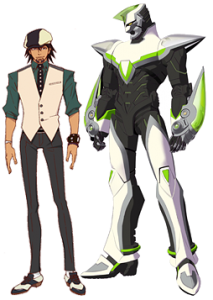 Kotetsu, as I mentioned is a single father and something of a failure as a hero. He breaks property, fails to make arrests, tries and fails to look cool, he generally can’t do anything right, and despite all his talk of what it means to really be a hero, he doesn’t even live up to his own standards, let alone everyone else’s. Even his few redeeming moments are actually ruined by the show’s dull writing, as even flash backs of his wife’s death, saving his daughter, and his own apparent death all manage to be not only entirely unmoving, but somehow eye-rollingly corny. Wild Tiger’s ads are for SoftBank Corp. (one of the lead telecommunication corporations in Japan) and S.H.Figuarts. (one of the most popular anime and tokusatsu related figure producers in Japan.) Like his partner, Barnaby, he is sponsored by Apollon Media.
Kotetsu, as I mentioned is a single father and something of a failure as a hero. He breaks property, fails to make arrests, tries and fails to look cool, he generally can’t do anything right, and despite all his talk of what it means to really be a hero, he doesn’t even live up to his own standards, let alone everyone else’s. Even his few redeeming moments are actually ruined by the show’s dull writing, as even flash backs of his wife’s death, saving his daughter, and his own apparent death all manage to be not only entirely unmoving, but somehow eye-rollingly corny. Wild Tiger’s ads are for SoftBank Corp. (one of the lead telecommunication corporations in Japan) and S.H.Figuarts. (one of the most popular anime and tokusatsu related figure producers in Japan.) Like his partner, Barnaby, he is sponsored by Apollon Media.
 Next up on the list would probably be Karina Lyle, alias: Blue Rose, the ice powered NEXT with the curvaceous body, skimpy hero outfit, and laughably lame catchphrase, which she herself dislikes. She is one of the only hero with only one major brand name, that being Pepsi. In one of the more stylistically clever moves in designing the show, the eye catch before the commercial break is actually an ad for Pepsi NEX, a fictional label of Pepsi cola named after the super powered NEXT. Karina’s back story amounts to her wanting to be a singer and using the super hero gig to launch her career. She develops a crush on Kotetsu that goes silently unrequited for the whole show. Even despite not wanting to be a hero and later deciding that she’ll do her best, she most often do next to nothing during hero calls and has in fact been rescued on a number of occasions. Other than a generic damsel in distress, she fits into the role of a tsundere love interest. Her corporate sponsor is Titan Industry.
Next up on the list would probably be Karina Lyle, alias: Blue Rose, the ice powered NEXT with the curvaceous body, skimpy hero outfit, and laughably lame catchphrase, which she herself dislikes. She is one of the only hero with only one major brand name, that being Pepsi. In one of the more stylistically clever moves in designing the show, the eye catch before the commercial break is actually an ad for Pepsi NEX, a fictional label of Pepsi cola named after the super powered NEXT. Karina’s back story amounts to her wanting to be a singer and using the super hero gig to launch her career. She develops a crush on Kotetsu that goes silently unrequited for the whole show. Even despite not wanting to be a hero and later deciding that she’ll do her best, she most often do next to nothing during hero calls and has in fact been rescued on a number of occasions. Other than a generic damsel in distress, she fits into the role of a tsundere love interest. Her corporate sponsor is Titan Industry.
The rest of these could go in any order, but I’ll start with Keith Goodman, alias: Sky High. A NEXT with the power of flight and wind manipulation, he starts the show out as “King of Heroes”, the top ranked hero on Hero TV. As a kind of joke it turns out that not only is he a model hero in costume, but even off duty he’s kind of a boy scout, but as a result of his rigidly positive attitude he’s actually kind of a boring and lonely person. His highlight episode actually shows him falling in love with the only woman possibly as mechanical and without a personality as himself, but the romance ends in sparks. Oddly enough this is probably the one and only somewhat moving incident in the entire show. He flies ads for USTREAM and Tamashii Nations. (Two more of Bandai’s subsidiaries, specializing in digital media distribution and product sales respectively.) His corporate sponsor is Poseidon Line.
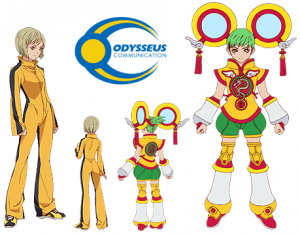 Next up is Pao-Lin Huang, alias: Dragon Kid. Inexplicably blonde despite being chinese. Pao-Lin is an electric powered NEXT as well as a skilled martial artist. She is something of a tomboy but generally gets very little screen time, so there’s not a lot to say about her. Her crazy, and extraordinarily cumbersome looking head doodads are ads for DMM.com (the computer, electronics, and DVD/CD distributor) and Calbee Foods Co. Her corporate sponsor is Odysseus Communication.
Next up is Pao-Lin Huang, alias: Dragon Kid. Inexplicably blonde despite being chinese. Pao-Lin is an electric powered NEXT as well as a skilled martial artist. She is something of a tomboy but generally gets very little screen time, so there’s not a lot to say about her. Her crazy, and extraordinarily cumbersome looking head doodads are ads for DMM.com (the computer, electronics, and DVD/CD distributor) and Calbee Foods Co. Her corporate sponsor is Odysseus Communication.
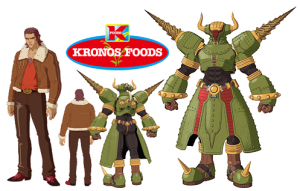 Another hero with very little screen time, Antonio Lopez, alias: Rock Bison. He was apparently a friend of Kotetsu’s but there was never a lot of clarification during the series itself. Supposedly the drama CDs clear this up a bit. He never even had his own spotlight episode. Like Blue Rose, he has just one major ad, Gyu-Kaku, a beef pot restaurant signs on either shoulder. His corporate sponsor is Kronos Foods.
Another hero with very little screen time, Antonio Lopez, alias: Rock Bison. He was apparently a friend of Kotetsu’s but there was never a lot of clarification during the series itself. Supposedly the drama CDs clear this up a bit. He never even had his own spotlight episode. Like Blue Rose, he has just one major ad, Gyu-Kaku, a beef pot restaurant signs on either shoulder. His corporate sponsor is Kronos Foods.
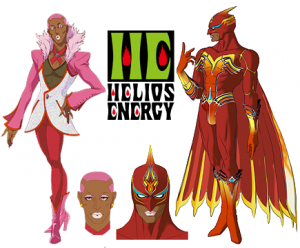 Next is Nathan Seymour, alias: Fire Emblem, a flamboyant gay black man with powers over fire. Again, a side character who receives very little time in the spotlight. His only big thing was that he had an expensive car to match his hero persona akin to a flaming red batmobile. He owns his own corporation, Helios Energy, and is thus a self-owned super hero. His outfit contains ads for FMV (Fujitsu Multimedia Vision) and Animate.
Next is Nathan Seymour, alias: Fire Emblem, a flamboyant gay black man with powers over fire. Again, a side character who receives very little time in the spotlight. His only big thing was that he had an expensive car to match his hero persona akin to a flaming red batmobile. He owns his own corporation, Helios Energy, and is thus a self-owned super hero. His outfit contains ads for FMV (Fujitsu Multimedia Vision) and Animate.
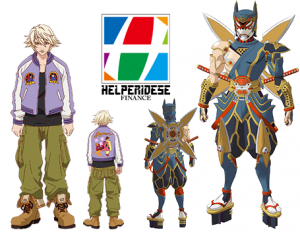 And finally we have Ivan Karelin, alias: Origami Cyclone. Despite apparently being of European decent his hero outfit is distinctly Japanese in theme. At the very start of the show he doesn’t actually do any hero work, instead showing up late to every call just to sneak himself into the camera frame at some point. His entire gimmick seems to be built around being some kind of Where’s Waldo character rather than a real hero, until he has his spotlight episode. His NEXT ability is to take the shape of other people. His spotlight episode also revealed that Sternbild is home to an actual NEXT school for heroes, though not much more detail is put into it. He is also notorious for being the hero with the most ads, and at first something of a sellout. Those ads include .ANIME, Takasu Katsuya Beauty Clinic (The joke here being that Ivan’s power is to change shapes and faces and Katsuya is a famous plastic surgeon.), what is apparently a cheer squad associated with Namco, and Livedoor. (A Japanese internet provider.) His corporate sponsor is Helperidese Finance.
And finally we have Ivan Karelin, alias: Origami Cyclone. Despite apparently being of European decent his hero outfit is distinctly Japanese in theme. At the very start of the show he doesn’t actually do any hero work, instead showing up late to every call just to sneak himself into the camera frame at some point. His entire gimmick seems to be built around being some kind of Where’s Waldo character rather than a real hero, until he has his spotlight episode. His NEXT ability is to take the shape of other people. His spotlight episode also revealed that Sternbild is home to an actual NEXT school for heroes, though not much more detail is put into it. He is also notorious for being the hero with the most ads, and at first something of a sellout. Those ads include .ANIME, Takasu Katsuya Beauty Clinic (The joke here being that Ivan’s power is to change shapes and faces and Katsuya is a famous plastic surgeon.), what is apparently a cheer squad associated with Namco, and Livedoor. (A Japanese internet provider.) His corporate sponsor is Helperidese Finance.
You may have noticed that other than Helperidese, which I can’t personally place, the names of all these companies are based on Greek mythos. Despite the entertaining thematic trend it actually bares no significance what so ever on the story. In fact the villainous organization, Ouroboros, arbitrarily breaks this trend in organization names by being Nordic rather than Greek. Just one of many clever little things in Tiger & Bunny that went to waste.
What disappointed me most, other that the outright wasted potential of a spectacular premise, was that none of the characters had any real character development what so ever. The only real change in anyone’s personality was to Barnaby’s: after the first major ongoing villain was defeated, a brief time skip reveals that despite the first dozen episodes being nothing but Kotetsu and Barnaby bickering, the two are suddenly best friends. Not good character writing. Worse yet, the entire climax of the final story arc sees the side characters reduced to delivering a remarkably flat, cookie-cutter friendship speech while Barnaby and Kotetsu fight the final boss.
Also disappointing was that nearly all the super hero action scenes were animated with 3D cgi models that were not only clunky and unnatural but in several cases just downright unattractive. I said before that I initially wasn’t interested in this show at all from the ads alone, and indeed a good part of that was because I thought, and still do think, that Barnaby and Kotetsu’s super hero outfits are just unattractively designed.
Despite the way I’ve been going on, it’s not as if the show was a total flop. It sold fairly well and has a long line of paraphernalia, as you might imagine with the abundance of logos and icons. It has even seen a sizable fan base in America already, including a number of cosplayers I saw during Otakon 2011, when the show wasn’t even done airing. I can’t say that the overall story and the character writing were outright “bad”, but they certainly weren’t anything special, which again is only emphasized by all the potential the show started with, but ultimately wasted. There were a few things that were done interestingly or at least started out promisingly, yet for every good idea that cropped up half a dozen mistakes followed to put a damper on things. As I mentioned before the eye catch with Blue Rose’s Pepsi NEX commercial was stylistically very clever (I do wish they had done other commercials with other heroes though); the over all premise, as I’ve been keen to remind you, was something genuinely unique with boundless potential; a few of the villain’s super powers, including the final boss’s were fairly clever; and the initial idea behind Kotetsu’s personal life was interesting, even if ultimately unfulfilled; several of the characters had interesting backgrounds, which got next to no attention; and the city and the Hero TV system itself were both initially very engrossing ideas with a lot of room to build upon.
Speaking of the setting, something that bothered me perhaps the most was that with such an interesting world set up around these heroes, almost everything got explained away by the end of the show. The origin of the super hero business, Hero TV, the villain, the heroes, the entire city itself almost. For something that should have felt like a huge world with an extensive history behind it, it was made to feel remarkably self contained by the end of things, which really defied the entire appeal behind the setting in the first place. Normally that’s just par for the course with an anime, but given the NA style comic book super hero mantle the show had been parading around it, I would have expected a more open feel to the world. Going back to my initial desire to see it turn into a working class drama, it really would have been much more interesting to see them work as a part of a much larger system, and not essentially turn against, and overthrow it like your typical corrupt government, only to magically maintain status quo come the final episode, as if the villain’s fall and sudden collapse of the foundations of a prominent social and economic figure had no impact what so ever on how the hero system affected their society.
The show also ended on a remarkably awkward sort of open ended cliff hanger, suggesting that there might be some kind of a second season, but from what I’ve seen of interviews with the creator these appear to red herrings and there are no actual plans for any kind of sequel as of yet. There is however the “Next Project”, Tiger & Bunny Hero Awards 2011. I will confess though, that I have no idea what this event is supposed to be beyond the title.
I know this has been a slightly out of place article -as I tend to recommend shows, movies, and manga, rather than review them- and to give a decidedly negative review of something is sort of counter productive. Even though I can’t deny that I was disappointed with the end product however, I still can’t help but feel like the initial idea is almost strong enough on its own. In any event, I have a feeling this show will continue to be a success, despite fairly obvious shortcomings, so for those of you reading who feel the need to keep on top of what’s popular, this may still be a show worth looking at, if only to sate your curiosity.



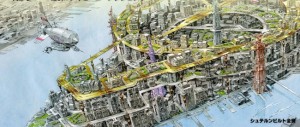



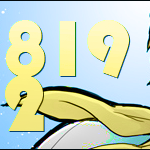

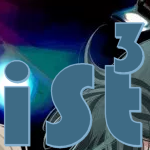









After reading this, I was looking back at Tiger & Bunny and found that some of your points are really good like the CGI in the anime. It was clunky, but some scenes with it looked amazing especially the ones at nighttime.
However, I still loved the series because it’s different from the rest of the season and that it tried to bring in a superhero-into-anime concept like Marvel and Madhouse and I thought it did average.
I don’t know if the “N.E.X.T. Project” is actually the rumored movie they are going for but who knows. Still a good read Bismarck.
As much as I wound up ragging on it I did still enjoy Tiger & Bunny, it just wasn’t what I was expecting or hoping for.
I can see what you are saying. I enjoyed the show as well, even if it is very easy to rag on…Especially since it is just so predictable. It is a fun series, and I would recommend it. Great article as well. 🙂
…I totally knew Kibs would pick a Blue Rose pic for the banner.
He shoulda done the King of Heroes, SKYYYYYYY HIGHHHHHHHH!
ARIGATO! SHOSHITE, ARIGATO!